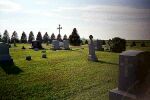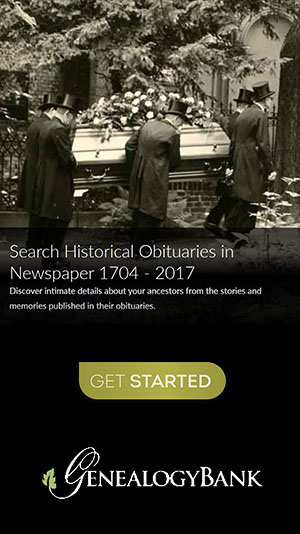Search South Dakota Death Records
 South Dakota Newspapers, Full Search (1861-2002), 38 titles
South Dakota Newspapers, Full Search (1861-2002), 38 titles South Dakota Obituary Search - (1999-current)
South Dakota Obituary Search - (1999-current) South Dakota Funeral Notices
South Dakota Funeral Notices
 |
| Click photo to enlarge |
 |
| Click photo to enlarge |
Saint John Cemetery
Prairie Township, Union County, South Dakota
T95N R50W Section 4
Lat: 43°04'12"N, Lon: 96°45'18"W
St. John Cemetery is one of four cemeteries along Union County's 298th Street, located approximately one mile south and one mile east of Beresford, South Dakota.
Contributed by Brian Hass, Aug 27, 2001 [brian_m_hass@hotmail.com].
Total records = 763.
Four cemeteries are adjacent to each other; St. John is the cemetery farthest
west. There are no fences or signs to mark the boundaries between these
four cemeteries. Many people think of the four collectively and less formally
as "The City Cemetery." The border between St. John Cemetery & Beresford
Cemetery is marked by an access road along it's southern half and a row
of trees along it's northern half.
St. John Cemetery is located on the southwest one-fourth of the east quarter of section four of Prairie Township, Union County, South Dakota. The 5.35 acres for St. John Cemetery were purchased from Mr. and Mrs. David Adams in 1886 at a cost of twenty dollars per acre. The total cost of one-hundred-and-five dollars as well as the fifty dollars for surveying and staking was paid for by donations from members of the Parish.
In 1889, a fence and gates were purchased and added to the property. In August 1894, the land was re-surveyed; and, a large cross was added to the center of the grounds. Trees were purchased and planted on the grounds in 1895 and 1896.
There are four blocks within the cemetery. The blocks are numbered one through four, going counter-clockwise and starting with the northeast block designated as Block 1. Each block contains seventy-two lots, each of which consists of a row of six graves. Within a given block, the space between any two adjacent lots located north or south of each other is equal to the width of one grave; and in a small number of cases, these spaces between lots have been used for additional burials. The majority of burials at St. John Cemetery are located throughout Blocks 3 and 4, and in the southern halves of Blocks 1 and 2.
The earliest known burial at St. John Cemetery is that of a sixteen-month-old child named Felix Phillip Mangan. This was recorded to have taken place on September 3, 1886. The most famous person buried at the cemetery is probably William J. Bulow, a former South Dakota governor and United States Senator.
The Catholic cemetery is well maintained; and, new burials still occur there relatively often. St. John Cemetery and the adjacent Beresford Cemetery are two of the most frequently used cemeteries in the area surrounding Beresford, South Dakota. The styles and sizes of the monuments at St. John Cemetery vary greatly.
The 2001 survey of St. John Cemetery was conducted by Brian M. Hass. The cemetery was visited on May 13 and 27, and June 3 of 2001 for the purpose of transcribing information from the inscriptions on all of the visible grave markers. Genealogical information was regarded to be the highest priority. This information was later typed into a text file.
In July of 2001, this data was compared to information contained in the 1990 and 2000 surveys of St. John Cemetery. To insure accuracy, disagreements between the data from 1990 and 2001 were noted and circled on a printout of the 2001 data. Additional information on possible unmarked graves was also noted during this time. The 2001 data was then compared to the 1940 WPA data as well. The cemetery was revisited on August 5, 12, 19, and 26 of 2001 for the purpose of determining whether or not the discrepencies between the 2001 data, and 1940 and 1990 data were the result of transcription errors in the 2001 data. Any disagreements between the 2001 data and the grave marker inscriptions were noted during these revisits; and subsequently, corrections were made to the 2001 data. Some additional data was also collected during these revisits. All work was performed by Brian Hass.
The 1940 WPA graves registration records were found to contain numerous name misspellings as well as few date and age errors. A few of the WPA misspellings sounded phonetically similar to the actual names when read out loud, but did not resemble those names otherwise. The grave coordinates in the 1940 WPA data were found to be similar to those listed in the 1990 and 2000 surveys; but often, the specific grave numbers did not match. The 1990 survey was also found to contain numerous name misspellings as well as a few errors in the dates and a large number of typographical errors. However, the errors in the 1990 survey did not seem to deviate as much as the errors in the 1940 WPA data did. The 2000 survey was found to contain fewer misspellings than the 1990 survey; but, it did contain a few. The burial coordinate data in the 1990 and 2000 surveys generally seemed to match quite well. The information above was gathered from the following sources:
1) 2001 St. John Cemetery Survey Notes by Brian Hass. This is a collection of hand-printed survey data and notes collected during visits to St. John Cemetery in 2001. The data includes names; dates and places of birth, marriage, and death; and, other data obtained from grave marker inscriptions. Special care was taken to insure that all names were transcribed accurately from the markers. This document includes corrections.
2) St. John Cemetery listing of graves, WPA Graves Registration Project, May 1940. The listing contains names, grave locations, dates of death, ages at death, genders, veteran status, and comments.
3) 1990 St. John Cemetery Survey. The author of this survey is not listed. The survey contains the names of all individuals known to be buried at St. John Cemetery, their years of birth and death, and the locations of the graves within the cemetery.
4) "St. John Catholic Cemetery", compiled by Anita Girard, April 25, 2000. This survey includes the names of all individuals known to be buried at St. John Cemetery as well as the locations of the graves. No dates of birth or death are listed. Graves reserved for individuals still living are also listed.
5) "St. John Cemetery", page 80 of the Beresford Centennial book Beresford_100_Years, published 1983 by the "Beresford Republic" and the "Lennox Independent." This contains some historical information on the cemetery.
6) "Beresford Republic" newspaper, Beresford, South Dakota. This contained all but one of the referenced obituaries that were used. All of the following data on marked graves was obtained from the first source; while, data for the unmarked graves was obtained from the second, third, and fourth sources. All maiden names in the data were obtained from the first source, unless they were noted as having been obtained from an obituary in the sixth source. Maiden names obtained from grave marker inscriptions were only listed inside parentheses in cases where the markers made it clear that the names were maiden names and not middle names. Otherwise, potential maiden names obtained from markers were listed without parentheses.
Each grave listed as "probably unmarked" was found listed in the older records but was not seen during the 2001 survey; and, the specific site was not checked to determine the presence of a marker. Every grave site listed as "unmarked grave" was checked to verify the absence of a marker. Attempts were made to systematically transcribe inscriptions on all of the visible markers at St. John during the survey; and, the probability of any markers being missed was extremely low.
Burial coordinates were listed for all unmarked or potentially unmarked graves. For some marked graves, burial coordinates were provided if the individuals buried there possessed identical or similar names to others buried in unmarked graves. The purpose of doing this was to provide evidence to resolve any perceived ambiguities and to prove that the individuals were not the same person.
Key: blk.="block" grv.="grave"
Records Listing:
Search South Dakota Cemeteries
Submit a Transcription
Help genealogists worldwide research their family history!
- No cost to publish your transcription- You retain all rights to your work
- No one can edit, change, or delete your work

